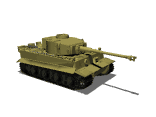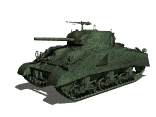|
|
|
|

Click Photo For Enlargement (131 Kb) |
|
|
|
Another shot of that slow-motion suspension. This thing can clear some
serious obstacles without any track slippage. I'm quite happy to find out
at least one thing works as intended on this thing (lol). The pivot points
for the suspension are just nuts welded onto the road arms which are then
threaded onto a threaded shaft and left loose enough to turn. Works like a
charm and with proper lubrication they should last as long as the tank does.
|
|
|
|
|
Here's the servo block and diode mixing assembly. I decided to take
advantage of the fact that the wiper motors have two sets of windings, a
high-speed low-torque winding and a low-speed high-torque winding. That
third switch on the forward/back servo operates the relays that switch
between the two. The servo at the top will be for the traverse control,
thus hasn't been finished yet (no turret to control yet). There's also a
decent look at the wheels from here. They are made from a pair of 1/2"
plywood circles glued together with a strip of rubber from an old tractor
inner tube glued and bradded onto them to dampen the "clickity-click" noise
from wood striking wood and ride on two, 7/8" rollerskating bearings.
|
|
|

Click Photo For Enlargement (113 Kb) |
|
|
|

Click Photo For Enlargement (112 Kb) |
|
|
|
Here's the relay-block for the right-track. I haven't gotten them
strapped down yet (still debating how I"m going to do it yet). The wiper
motor speed control is on the ground side so the center poles of the speed
control relay and the reverse relay are connected together. The speed
control relay then conects to the low speed (NC position) and high speed (NO
position) windings of the right motor. The left motor of course has its own
relay block that is identical to this one. Other than the added speed
control this is identical to a normal diode mixing speed control as seen in
the "How-to" part of the www.rctankcombat.com website.
|
|
|
|
|
Power is supplied by a pair of windshield wiper motors. They got piping
hot in tests (to the point that they could, and did burn anyone who touched
them) so I added strips of 1/2" U-channel aluminum to the sides. After
blowing up one motor in a later test I found that the bushing housing on the
end of the motor was still overheating thus it got its own heatsink (that
cute little thing on the end of the motor) which seems to have more than
taken care of the problem.
|
|
|

Click Photo For Enlargement (127 Kb) |
|
|
|

Click Photo For Enlargement (120 Kb) |
|
|
|
The motor power is delivered via these automotive belts to the
driveshafts through a 3:2 overdrive gear ratio. This brought the thing's
speed up to where I don't think I'll simply be laughed right off of the
field though I'm still worried about shaft power (aka, maneuverability in
grass). We'll find out this fall in Calgary if this thing'll have what it
takes or not.
|
|
|
|
|
|
|



